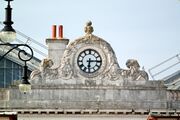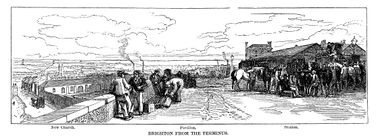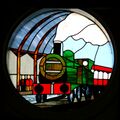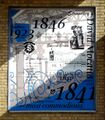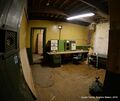Category:History of Brighton Railway Station
| Brighton Station |
|---|
History of Brighton Railway Station |
|
Station | History | CabRoad | GoodsTunnel | LocoWorks | Greenway | ToyMuseum |
~1844: Brighton Terminus [image info]
~1846: "Brighton from the Terminus", "Railway Chronicle Travelling Chart or Iron Road Book", "London-Brighton", James Holmes [image info]
~1870s: Brighton Terminus [image info]
1885: Engraving of Brighton Station's interior [image info]
Fenchurch Walk plaque showing Brighton Station [image info]
Steam locomotive at Brighton Station (stained glass window at Brighton's Palace Pier) [image info]
The construction of Brighton Railway Station and the London to Brighton railway line in 1841 transformed Brighton, with Londoners easily able to easily get to the town for a day out by the seaside. Faced with this influx of holiday makers with spending money, Brighton's population boomed and the town underwent a period of huge growth.
Alternative locations
Other locations were originally considered for the terminus of the London-to-Brighton line. One suggestion was to put the station just north of Western Road, near the Brunswick Estate, but residents objected to the idea that their genteel area might be then be flooded with visiting Londoners.
Another suggested location was at or around The Level - the wedge of open land at the top of the the chain of green areas running up from Old Steine. Putting the station in this valley area would have been more convenient for visitors as it would have provided a grand route down to the most popular section of the seafront, and it would have allowed a comparatively easy route to London, but having a valley on each side would have made it difficult to build connecting branch lines to the other towns on either side of Brighton.
The station was finally constructed by building up on the side of a hill between these two locations, by excavating a vast amount of material from the chalk hillside and nestling the station into the resulting brick-shored cliff. This location provided enough height for the London Road Viaduct to straddle the valley area to the East to give a route to London, and also allow routes to the West what would have been more difficult if the station had been nestling at the bottom of a valley.
History of Brighton Station - timeline
- 1837 – London and Brighton Railway Act passed
- 1838 – Construction work starts
- 1839 – Mocatta station house designed
- 1840 – Shoreham branch line opens, initial Shoreham terminus building at Brighton.
- 1841 – main line opens, Mocatta building finished
- 1844 – West Street extended to the Station, as Queens Road
- 1844 – Initial Trafalgar Street Bridge
- 1846 – LBRC joins London and Croydon Railway Company to create the London, Brighton and South Coast Railway (LB&SCR)
- 1847 – branch line to Lewes and Newhaven opens
- 1852 – new goods branch line built
- 1863 – Trafalgar Street Bridge widened
- 1875 – Trafalgar Street Bridge widened for a second time
- 1882 – New longer glass station platform roof built over the existing roof (removed 1883)
- 1882-83 – station extended eastward over the Cab Road,
- New buildings built along the East and West sides
- Jutting parcels depot
- Demolition of Mocatta ground floor frontage, construction of forecourt roofing
- 1883 – Cab road redesign
- 1883 – Suspended four-faced clock
- 1883 – Rear of Mocatta building ground floor extended back
- 1883 – Electric lighting fitted
- 1899 – Roof steps added for maintenance access
- 1924 – Creation of new stair access to Trafalgar Street
- 1979 – Travel Centre created
- 1980 – New Ticket Office
- 2013 – Building work on travel centre and other centre station frontage, internal reorganisation
Other external references
- Keith Leicester and Ron Martin, Brighton Station - an Architectural and Historical Appraisal, Sussex Industrial History: Journal of the Sussex Industrial Archaeology Society issue 28 (1998) pages 4-11 ISSN 02635151
- Basil K. Cooper Rail Centres: Brighton (Ian Allan, 1981, 1991) ISBN 0711011551
- Image of Brighton Station, in its original configuration (schoolnet.co.uk)
- Images of England
Subcategories
This category has the following 6 subcategories, out of 6 total.
Pages in category ‘History of Brighton Railway Station’
The following 3 pages are in this category, out of 3 total.
Media in category ‘History of Brighton Railway Station’
The following 24 files are in this category, out of 24 total.
- Brighton Railway Station building, clock.jpg 2,200 × 1,467; 1.73 MB
- Brighton Station (stained glass at Brighton Palace Pier).jpg 1,600 × 1,600; 219 KB
- Brighton Station interior, engraving (NGB 1885).jpg 1,600 × 1,080; 526 KB
- Brighton Station, David Mocatta building, rear.jpg 1,024 × 683; 499 KB
- Brighton Terminus, lineart (1870s).jpg 1,024 × 605; 455 KB
- Brighton Terminus, lineart (~1840s).jpg 1,024 × 657; 413 KB
- Cab Road 011 (UnderBrightonStation 2018-01-18).jpg 3,000 × 2,000; 3.16 MB
- Cab Road 018 (UnderBrightonStation 2018-01-18).jpg 3,000 × 2,000; 2.9 MB
- Cab Road 019 (UnderBrightonStation 2018-01-18).jpg 3,000 × 2,000; 2.34 MB
- Cab Road 020 (UnderBrightonStation 2018-01-18).jpg 3,000 × 2,000; 3.35 MB
- Cab Road 021 (UnderBrightonStation 2018-01-18).jpg 3,000 × 2,000; 2.77 MB
- Cab Road 022 (UnderBrightonStation 2018-01-18).jpg 3,000 × 2,000; 3.48 MB
- Cab Road used for an art exhibition (NLR 282 2023-10).jpg 2,110 × 3,000; 1.32 MB
- Cab Road, view in (UnderBrightonStation 2018-01-18).jpg 3,000 × 2,000; 3.07 MB
- Cab Road, view out (UnderBrightonStation 2018-01-18).jpg 3,000 × 2,000; 2.48 MB
- Cab Road, view out, deeper (UnderBrightonStation 2018-01-18).jpg 3,000 × 2,000; 2.55 MB
- Fenchurch Walk Brighton plaque 7 of 7.jpg 1,078 × 1,229; 208 KB
- Goods Tunnel with rooms (UnderBrightonStation 2018-01).jpg 3,000 × 2,000; 3.6 MB
- Intersection of the Cab Road and Goods Tunnel (UnderBrightonStation 2018-01-18).jpg 3,000 × 2,000; 3.82 MB
- John Peel mural, Frederick Place, 2011.jpg 2,200 × 1,650; 580 KB
- Rifle Range, back view (UnderBrightonStation 2018-01).jpg 3,000 × 2,000; 2.93 MB
- Stairs to platform level (UnderBrightonStation 2018-01).jpg 2,400 × 3,000; 2.49 MB
- Wartime offices, Goods Tunnel (UnderBrightonStation 2018-01).jpg 3,000 × 2,532; 3.15 MB
